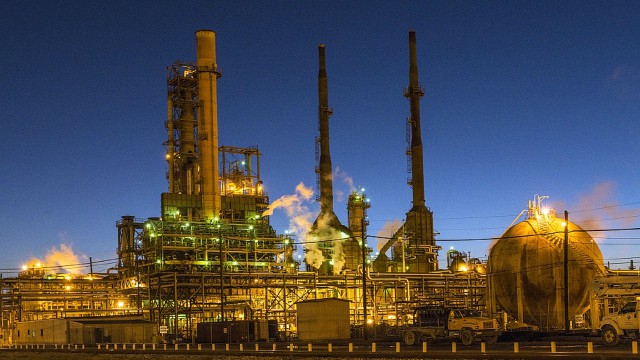Energy stocks have experienced meaningful dips recently. So, now may be a good time to take a look at the stocks for potential purchases.
If you’re looking for low-risk exposure to the energy space, you can consider Imperial Oil Limited (TSX:IMO)(NYSE:IMO), Suncor Energy Inc. (TSX:SU)(NYSE:SU), and Canadian Natural Resources Limited (TSX:CNQ)(NYSE:CNQ). Their shares have declined about 22%, 8%, and 16%, respectively, from their 52-week highs.
Low volatility
Volatility is one way of looking at risk. Imperial Oil and Suncor historically have lower volatility than the market. So, they’re viewed as lower risk. Then there’s Canadian Natural Resources, whose volatility matches the market’s.
Large size
Large-cap energy stocks are lower-risk investments than small-cap energy stocks because the former group has stronger balance sheets and more financial flexibility.
Imperial Oil has a market cap of about $32 billion, a strong S&P credit rating of AA+, and a low debt-to-cap ratio of 16%.
Suncor has a market cap of about $68 billion, a decent S&P credit rating of A-, and a reasonable debt-to-cap ratio of 25%.
Canadian Natural Resources has a market cap of about $43 billion, an investment-grade S&P credit rating of BBB+, and a reasonable debt-to-cap ratio of 30%.

Diversified business
Suncor and Imperial Oil are integrated businesses which are much more diversified than small-cap energy stocks that only engage in oil and gas exploration and production.
For example, Suncor has operations in oil sands development, oil and gas production, petroleum refining, and product marketing under its network of Petro-Canada gas stations across Canada.
Because of their integrated businesses, Suncor and Imperial Oil are less affected by low commodity prices. However, they will also benefit from higher commodity prices. Essentially, they will experience less upside when commodity prices rise and less downside when commodity prices fall compared to smaller energy companies.
Canadian Natural Resources’s product mix is more diversified than a small energy company which may be heavily weighted towards either oil or gas.
In 2017, Canadian Natural Resources’s product mix is estimated to be 30% natural gas, 29% oil sands mining and upgrading, 27% heavy crude oil, and 14% light crude oil and natural gas liquids.
Growing dividends
Investors can view received dividends as getting a part of their investment money back. So, it’s helpful when Imperial Oil, Suncor, and Canadian Natural Resources increase their dividends over time.
Since 2007, Imperial Oil’s dividend per share (DPS) has increased at a compound annual growth rate (CAGR) of 6.3%. In the same period, Suncor and Canadian Natural Resources increased their DPS at a CAGR of 22.7% and 20.1%, respectively.
Investor takeaway
Although these are low-risk energy investments, it doesn’t mean there’s no risk. In fact, if you’d bought shares at the start of 2007, you would have experienced annualized returns of about 0% for Imperial Oil and Suncor and 3.5% for Canadian Natural Resources.
The phrase “buy low and sell high” doesn’t ring truer than this.
Analysts at Thomson Reuters estimate that Imperial Oil, Suncor, and Canadian Natural Resources have upside potential of about 17%, 18%, and 33%, respectively, from their recent quotations of $41.25, $37.99, and $39.34 per share.
With their double-digit upside potential, now may be a good time to consider some shares. Don’t go all-in at once, though. Consider saving some cash to buy more on further dips.








